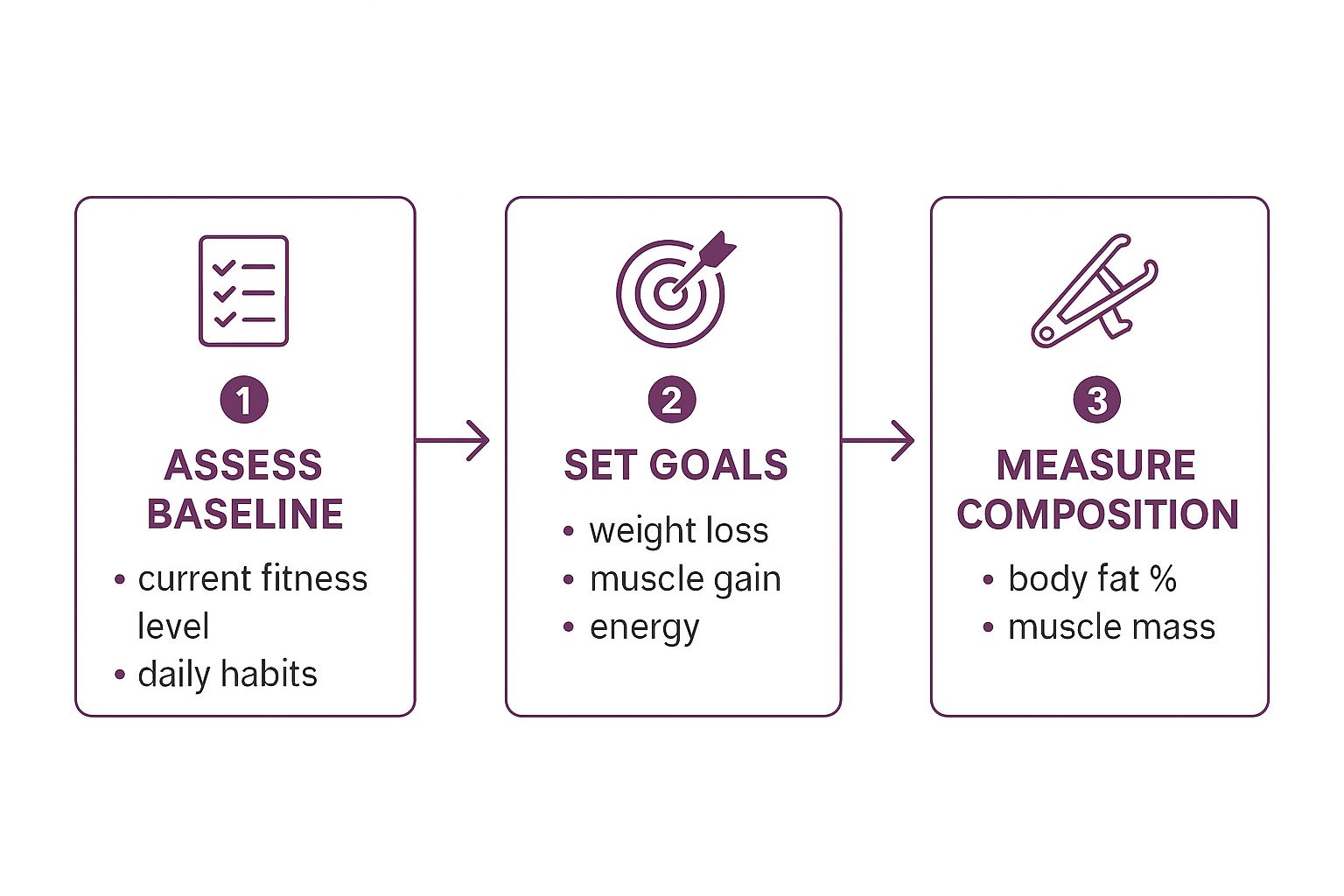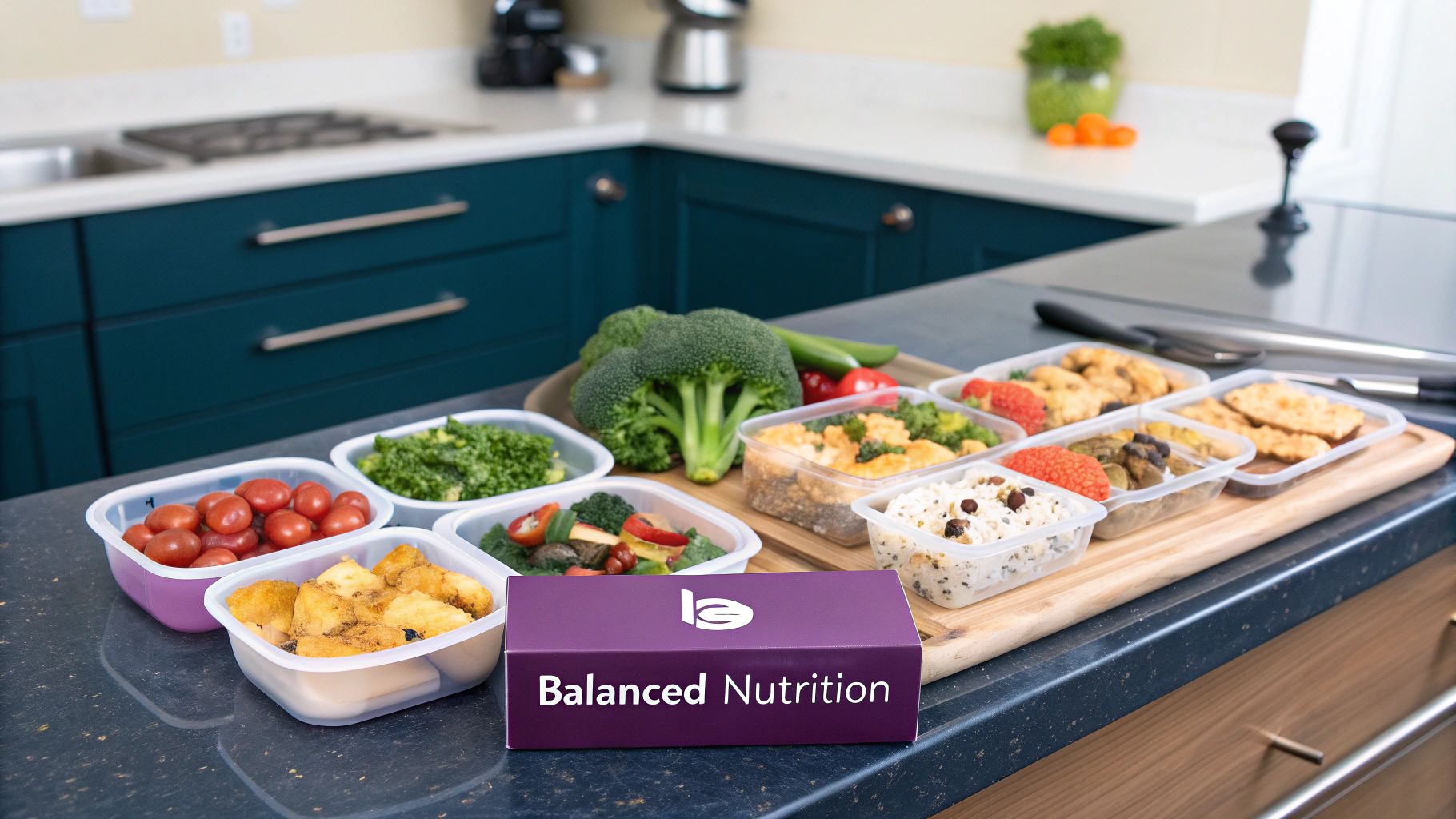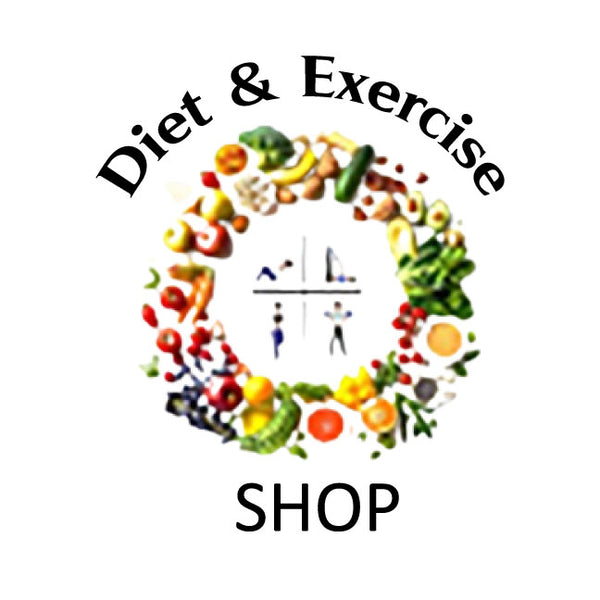
Your Ultimate Diet and Workout Plan for Real Results
A truly effective diet and workout plan isn’t something you download; it’s something you build. It’s a personal roadmap, starting with where you are and clarifying where you want to go.
Getting this foundation right is everything. It makes your plan realistic, sustainable, and capable of delivering results that stick.
Building Your Personalized Fitness Blueprint
Jumping into a new fitness routine can feel overwhelming. Every great plan begins with a simple, honest check-in. Before you can get to your destination, you need to know your starting point.
This means taking a judgment-free look at your current fitness level and daily habits. This isn't about picking yourself apart; it's about collecting data to build a strategy designed for you.
This initial assessment becomes your baseline—the "before" picture you'll look back on. More people are embracing this, with nearly 75% of people worldwide planning to focus more on their health. You can dig into these health and fitness marketing trends to see the shift.
Setting Meaningful and Motivating Goals
Once you know where you stand, it's time to decide where you're headed. Your answer will shape every decision you make.
- Weight Loss: The goal is a consistent calorie deficit. Combine a balanced diet with a mix of cardio and strength training.
- Muscle Gain: Looking to build strength? Focus on resistance training and a diet packed with protein for muscle repair and growth.
- Increased Energy: To feel more vibrant, focus on nutrient-dense foods, consistent movement, and quality sleep to fuel your body and mind.
The process is logical: figure out your baseline, set clear goals, and then measure your body composition.

This three-step approach creates a solid foundation, which is critical for long-term success.
Here’s a quick guide to connect common fitness goals with the right focus areas and tracking metrics.
| Fitness Goal | Diet Focus | Workout Focus | Key Metric to Track |
|---|---|---|---|
| Fat Loss | Sustainable calorie deficit, high protein, and fiber intake. | Combination of strength training and cardiovascular exercise. | Body fat percentage, measurements. |
| Muscle Gain | Calorie surplus with a high-protein diet (1.6-2.2g per kg). | Progressive overload in resistance training (lifting heavier). | Lean body mass, strength increases. |
| Improve Endurance | Adequate carbohydrates for fuel, proper hydration. | Steady-state cardio and high-intensity interval training (HIIT). | VO2 max, resting heart rate, run times. |
| Boost Energy | Nutrient-dense whole foods, balanced macronutrients, minimal sugar. | Consistent, moderate-intensity activity and prioritizing sleep. | Subjective energy levels, sleep quality. |
This table gives you a clear starting point for aligning your actions with your ambitions.
Why Body Composition Matters More Than Weight
The number on the scale tells a very small part of the story. It lumps everything together—fat, muscle, water, and bone—without context.
That's why understanding your body composition, the ratio of fat mass to lean mass, is a more powerful way to track progress. Measuring it lets you see if you're losing fat and gaining muscle—progress a simple scale might miss.
To get a clear picture right from the start, use a tool designed for the job. The Digital Body Fat Caliper from dietexerciseshop.com gives you precise measurements. It takes the guesswork out of the equation and gives you reliable data to stay motivated.
Fueling Your Body the Right Way
You can't out-train a bad diet. What you do in the kitchen is just as important, if not more so, than what you do in the gym.
It’s easy to get lost in fad diets and conflicting advice. The foundation of lasting results is understanding how your body uses food as fuel.

This comes down to macronutrients. Getting the right balance unlocks your fitness goals, whether you're building muscle or getting lean.
Understanding Your Macronutrients
"Macros" are the nutrients your body needs in large quantities. They provide the energy (calories) for everything you do.
- Protein: This is your muscle-building crew. After a workout, protein rebuilds torn muscle fibers, making them stronger. Think chicken, fish, beans, and tofu.
- Carbohydrates: Your primary fuel source. Carbs power your brain and give you energy for high-intensity exercise. Go for complex carbs like oats and brown rice.
- Fats: Don't avoid healthy fats! Sources like avocados, nuts, and olive oil are essential for hormones, vitamin absorption, and cell health.
To dial this in, you'll need a little math. For a step-by-step guide, check out our article on how to calculate your macros.
Building Your Perfect Plate
Knowing your macros is the first step. The magic happens when you put them on your plate. Build balanced meals that support your energy levels all day.
A well-structured meal plan simplifies healthy eating. Studies show that people who plan their meals are far more likely to maintain a balanced diet and achieve their weight management goals.
A high-protein breakfast, like eggs with spinach, sets your day up for success. For lunch, grilled chicken over quinoa with a salad will power you through the afternoon.
And don't forget hydration. Water is involved in every process in your body. Eight glasses a day is a good start, but you’ll need more if you're active.
Mastering Portions Without the Hassle
Where do most people go wrong? Portion sizes. It's easy to overeat even "healthy" foods, which stalls your progress.
While counting every calorie works for some, most people burn out on it quickly. It's not sustainable long-term.
A more practical approach is using tools that remove the guesswork. Our Portion Control Plates and Containers give you clear visual guides for protein, carbs, and fats. It's a simple system to master portions without stress.
Crafting a Workout Routine That Actually Works
The best diet and workout plan is the one you can stick with. It's about building a schedule you don't dread.
An effective plan balances three pillars: cardio for heart health, strength training for muscle, and flexibility for mobility. This combination sets you up for long-term success.

This holistic approach is becoming mainstream. In the US, 58% of gym members show up at least twice a week. That’s real commitment. You can dive deeper into these impressive gym membership statistics to see the trend.
Building Your Weekly Schedule
Putting together a weekly schedule shouldn't be complicated. A great way to start is by mixing different training styles. This keeps things fresh and challenges your body in different ways.
Here’s a sample week that provides a great balance:
- Monday: Full-Body Strength Training
- Tuesday: Moderate-Intensity Cardio (brisk walk or bike ride)
- Wednesday: Active Recovery (stretching or yoga)
- Thursday: Full-Body Strength Training
- Friday: High-Intensity Interval Training (HIIT)
- Saturday: Light Activity (long walk or hike)
- Sunday: Complete Rest
This setup gives you a solid mix of intensity and recovery. If you're just starting, our guide on workout routines for beginners at home has simple, effective plans.
Progressive Overload Is Your Key to Progress
To keep seeing results, you must embrace progressive overload. This means gradually making your workouts more challenging over time. If you don't, your body will adapt, and your progress will stall.
Progressive overload is the foundation of getting stronger, faster, and fitter. It challenges your muscles to adapt, ensuring you never hit a plateau.
You don't need a pricey gym membership. A great full-body workout is achievable at home with the right gear. Tools like a quality Resistance Bands Set or an Adjustable Dumbbell are perfect. As you get stronger, you can increase the resistance or add more weight.
Getting your form right is non-negotiable for safety and results. For clear visual guides, check out the Diet & Exercise YouTube channel. Following expert-led tutorials ensures you do each move correctly.
Making Fitness Fit Your Life
A perfect diet and workout plan is useless if you can't follow it. The secret is weaving fitness into the life you already lead. Turn new habits into something that feels automatic.
Consistency always beats intensity. A quick 20-minute workout on a busy day is better than skipping it altogether. This shift in thinking separates people who see results from those who quit.

Convenience is King
If a healthy choice is hard, you probably won't make it. The trick is to remove friction between you and your goals. This starts with smart prep.
Meal prepping doesn't have to be an all-day affair. Pre-chop veggies for the week, cook a batch of quinoa, or grill chicken breasts for salads.
For workouts, lay out your gym clothes the night before. It's a tiny action, but it's a powerful psychological nudge.
Research shows that individuals who plan their meals and workouts are more likely to stick to their fitness goals. Convenience and preparation are cornerstones of a sustainable healthy lifestyle.
Having the right tools for on-the-go moments makes all the difference. Our Portable Blender is a game-changer for packed schedules. Whip up a protein shake or smoothie in seconds, whether at your desk or in your car. It’s the ultimate hack for getting good nutrition when short on time.
How to Stay on Track When You're Out and About
A social life shouldn't derail your progress. With a bit of foresight, you can enjoy a night out without sabotaging your hard work.
Before leaving for a restaurant, pull up the menu online and decide what you'll order. This helps you avoid last-minute, less-healthy choices.
At parties, make conversation the main event, not the snack table. If you're drinking, alternate each alcoholic beverage with a glass of water. A flexible plan accounts for real life—it's about balance without guilt.
Tracking Progress and Making Adjustments
Your plan isn't set in stone. It's a roadmap you'll adjust as you go. The magic happens when you listen to your body, track what's working, and switch things up when you hit a wall.
First, stop letting the scale dictate your mood. It’s just one piece of the puzzle. True progress is something you feel.
Are your clothes fitting better? Do you have more energy? Are you hitting new personal records? Those are the wins that really count.
The scale can't distinguish between a pound of fat and a pound of muscle. Focusing on non-scale victories like improved energy and body measurements gives you a more accurate picture of your progress.
This is where the right tools make a world of difference. To see what’s really happening with your body composition, you need to look beyond weight. The Smart Body Fat Scale from dietexerciseshop.com was built for this. It tracks key metrics like body fat percentage and muscle mass, so you can see changes a regular scale would miss.
Identifying and Breaking Through Plateaus
Everyone hits a plateau. It’s that frustrating moment when progress stalls, no matter how hard you're working. Don't panic. This is a normal part of the process.
If your numbers haven't moved for a few weeks, it's time to shake things up. Here are a few things that almost always work:
- Switch Up Your Workout: Your body gets bored. Try new exercises, bump up the intensity, or add an extra training day.
- Re-evaluate Your Diet: Take an honest look at what you’re eating. A small tweak to your calorie or protein intake can reignite progress.
- Focus on Recovery: Are you sleeping enough? Pushing yourself without quality rest is a recipe for burnout and stalled results.
The good news is that there are more resources than ever. The global fitness industry is booming, growing by 8% annually. You can learn more about the global fitness industry's record growth and see how you can benefit.
Common Questions About Diet and Workout Plans
When you start a new diet and workout plan, questions are normal. Am I doing this right? When will I see changes? It's a lot to take in.
This section cuts through the noise. I've gathered the most common questions and will give you straight-up, practical answers. Think of it as a quick chat with a coach to help you move forward.
How Long Until I See Results?
Every body responds differently, but you'll likely feel benefits almost right away. Within the first few weeks, most people notice more energy and a better mood.
Visible changes—more muscle definition or a leaner physique—usually show up after about 4 to 8 weeks of consistency. This is a long game, so celebrate small wins along the way.
A great way to measure what's happening is to look beyond the scale. The Smart Body Fat Scale is a game-changer because it tracks things like muscle mass and body fat percentage, which a standard scale can't show you.
Do I Really Need to Count Calories?
Honestly, no. While calorie counting helps some, it’s not sustainable for many. A simpler approach is to master portion sizes and fill your plate with whole, nutrient-dense foods.
This is why we created our Portion Control Plates. They take the guesswork out of it. By visually guiding you to load up on lean proteins and veggies, you naturally manage your intake and stay full without counting calories.
What’s the Single Best Exercise for Losing Weight?
There isn’t just one! The most effective approach is a smart mix of strength training and cardio. Cardio burns calories, but building lean muscle through strength training fires up your metabolism long-term.
The "best" exercise is the one you'll actually do. Find something you enjoy. For building foundational strength at home, a versatile Resistance Bands Set is one of the most effective tools you can own.
How Do I Stay Motivated When I Just Don’t Feel Like It?
Motivation comes and goes. The secret weapon is discipline. It carries you through on the days you’re just not feeling it.
Instead of skipping a workout, just scale it back. A shorter routine or a quick walk is enough to keep the habit going. And having a simple setup at home, like a pair of Adjustable Dumbbells, removes one of the biggest excuses—the trip to the gym.
Here at Diet & Exercise, our mission is to make fitness fit into your real life. We hand-pick tools and apparel that support your journey, from great home workout gear to apparel that makes you feel good. Check out our collections and find what you need to build a healthier, stronger you. Head over to dietexerciseshop.com to get started.
